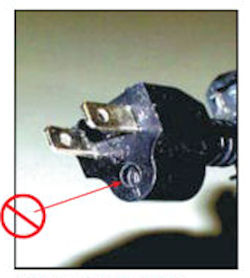Grounding
The term "ground" refers to a conductive body, usually the earth. "Grounding" a tool or electrical system means intentionally creating a low-resistance path to the earth. When properly done, current from a short or from lightning follows this path, thus preventing the buildup of voltages that would otherwise result in electrical shock, injury and even death.
Under certain conditions, even a small amount of electric current can result in fibrillation of the heart and death. An electric shock also can cause the user to fall off a ladder or other elevated work surface and be injured due to the fall.
Three-wire cords contain two current-carrying conductors and a grounding conductor. Any time an adapter is used to accommodate a two-hole receptacle, the adapter wire must be attached to a known ground.

To protect the worker from shock and burns at work, make sure electrical powered tools have a three-wire cord with a ground. To avoid hazards:
- Ground all power supply systems, electrical circuits, and electrical equipment.
- Frequently inspect electrical systems to insure that the path to ground is continuous.
- Visually inspect all electrical equipment before use. Take any defective equipment out of service.
- Do not remove ground prongs from three-prong equipment or extension cords. This is one of the most common electrical cord violations cited by OSHA.
- Use double-insulated tools and equipment, distinctively marked.
- Ground all exposed metal parts of equipment.
- Ground metal parts of the following non-electrical equipment, as specified by the OSHA standard [29 CFR 1926.404(f)(7)(v)]:
- Frames and tracks of electrically operated cranes.
- Frames of non-electrically driven elevator cars to which electric conductors are attached.
- Hand-operated metal shifting ropes or cables of electric elevators.
- Metal partitions, grill work, and similar metal enclosures around equipment of over 1kV between conductors.
Knowledge Check Choose the best answer for the question.
3-7. What is one of the most common electrical cord violations cited by OSHA?
You forgot to answer the question!
